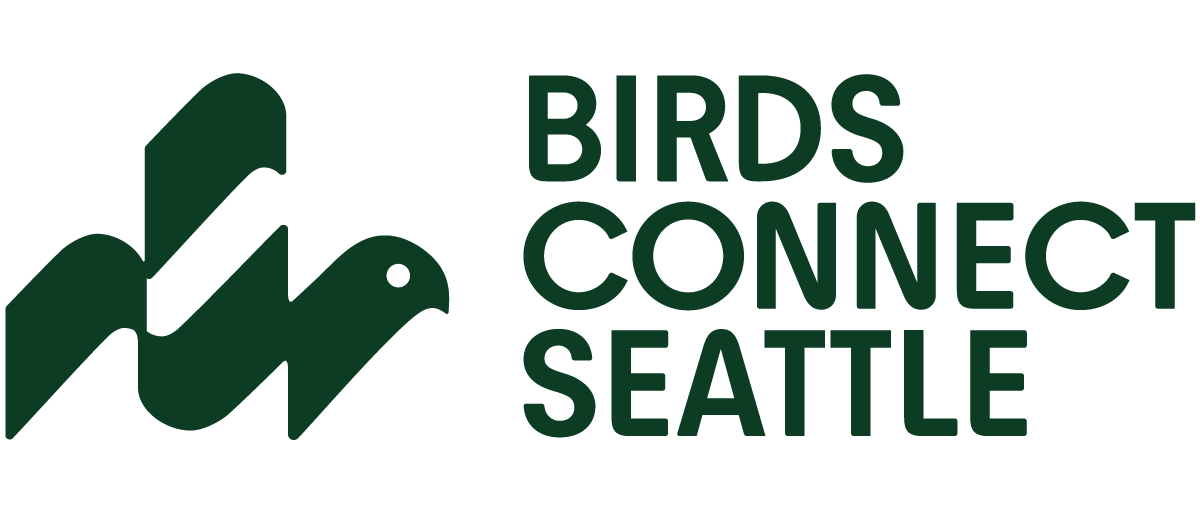The Nature Shop windows become beautiful and bird friendly
We spoke with Angelina to see what she has learned from her experience creating this custom piece of art for our windows, and also to learn about her inspirations, challenges, and hopes for members of our Seattle community that appreciate both art and nature.
Seattle Audubon: You incorporate nature, and specifically Pacific Northwest elements of nature like birds, plants, flowers, and marine life into your murals. What about those subjects inspires you?
Angelina Villalobos: I grew up listening to stories by Beatrix Potter and was particularly interested in the bunnies from her stories – their emotions, their personalities. To me, I see animals as individuals and even the birds that visit my back yard feeders all have different personalities. I have also been heavily influenced by folklore and fairytales, as well as Anime, Graffiti and hip-hop culture. I am not a scientific illustrator, but rather, I observe the world and interpret it through my unique artist’s Lens.
As a child I always wanted to be a Ninja Turtle like my brothers, but was always told because I was a girl, I could only play the girl roles so drawing them allowed me to be able to become part of the character’s world on my terms.

AV: The challenge is the enjoyable part.
Art should be accessible to everyone in our communities.
I have been fortunate enough to visit the Louvre in Paris and the Hermitage Museum in St Petersburg which are amazing places to see art, but they aren’t accessible to everyone.
We need to put art where we can fit it in—in every neighborhood. I don’t want my art to be exclusive or something that is hoarded away in a private residence somewhere. I painted a Volvo for a man once and a friend of mine would always call me when she saw it on the highway. It was nice to know my artwork was being seen, and if he had commissioned a painting for me instead that wouldn’t have happened.
AV: One concern I had about the project initially was balancing the functionality of the bird collision deterrent aspect (the window cling decal itself) with the ability for natural light to still shine into the space. I feel as though natural light is important to not only me as an artist, but also anyone who might be working in The Nature Shop. The careful balance that makes projects like this so special; coexisting so we all get what we need.
I also had to carefully consider positive and negative space, the black and white, or in this case white space (decal) and clear space (window). I had to be very mindful of the line work, making sure all gaps of 2” were filled in order to be an effective collision deterrent. As you can see from my drafts, at one point in the process we actually inverted the use of the decal vs window to make the design more visually appealing but I wasn’t able to “see” this at first.
AV: I now know what happens to birds when they hit windows, and so I am glad that I am able to make a window collision deterrent. Since completing this project, I have become a member of Seattle Audubon because I am interested in the work they are doing in our community.
AV: The whimsical design is where I feel most comfortable as you can see from my common design themes related to fairytales and folklore. When creating something for a client I also try provide a design option that is out of my comfort zone. In this case, it was the wood block style. This creation process allows me to evolve and grow.
One other technique I often use is drafting a few options that evoke different emotions so the client can weight in. In my work for Seattle Audubon, I spent a lot of time specifically on the face and the eye of the Varied Thrush in order to achieve the right emotion in his expression—perhaps one of determination.
AV: Construction and development have forced both artists and families out of the city.
I think it is important for our children to be exposed to art and nature to spark interest, shape the way they want to be in the world, and then when they grow up, they can incorporate those values into their own communities—creating a legacy.
If you don’t provide access to art and nature you can’t create that connection and build legacy. Urban and marginalized communities are in particular need of both as their accessibility to reach museums, zoos or parks, is often limited.
AV: Word of mouth is the key. I am a “mixer”. I think of this specific tool we use in my family to make Mexican chocolate, and that is me—twirling and whirling until it is blended. I connect different kinds of artists to one another. I connect myself with various neighborhoods in the city.
We need to stop getting stuck doing the same thing over and over and instead, build connections in the community, and between communities.
Doing this work for SA was a great way to end 2020 and set the tone for 2021.
Learn More and Support Angelina

Seattle Audubon was honored to have Angelina speak about her work as an artist and activist alongside Seattle Audubon’s Urban Conservation Manager, Joshua Morris, at our January Program Meeting. Here’s a recording of the event.
Other articles in this issue of Earthcare Northwest
Enhancing Environmental Education with Art
by Hanae Bettencourt
Songs Aren’t Just for the Birds
Spotlight on musician Whitney Neufeld-Kaiser
Nesting in Trash
Spotlight on artist Laurel Mundy







